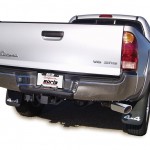Bike carrier solutions are a great way to transport your bike. Even if a bicycle is a perfect method of going from point A to point B, sometimes you can’t rely solely on the bike itself. Bikes are great for when you want to exercise, save on gas, or even regulate your carbon footprint, but sometimes you just need a carrying solution so that you can enjoy riding your bicycle in more distant locations.
A bike rack for cars is pretty much the ideal solution for this, although there are a few different types of racks, as well as things you should know about them. Some of the things you should consider before getting one are how often are you going to use it, how many bikes you’ll be transporting, and of course, how far you want to go in terms of spending.
Rear-Mounted Racks

There is a reason why rear-mounted bike racks are the most common, and that’s affordability and ease of use. These types of racks are often the first, and sometimes only, type of rack people get for transporting their bikes, hence their undying popularity. This is a great type of bicycle rack for car owners that don’t want to deal with complicated add-ons and merely want to transport their bike. They have a relatively basic design with a frame that straps to the back of the car, and with two arms on which the bikes are secured on. When you’re initially fitting this type of rack, make sure to tighten all of the straps as much as possible, and don’t forget to use some padding between the bikes, because it is possible to damage them otherwise.
However, even despite their enduring popularity, there are a few things you should be aware of, first. Most rear-mounted racks are specific to certain car models, so make sure you’re getting one that fits. They prevent access to the boot, and they usually make your car lengthier on the sides, so you should be aware of your car’s potentially increased width.
But, even with these potentially large setbacks, they are still a great option. They’re quite easy to use, and your bike will be secure, even if the rack itself might feel wobbly. On top of that, their affordability often trumps most other types of racks just for that fact alone.
Roof-Mounted Racks

The roof-mounted bike car rack, as the name implies, is strapped laterally on the roof of the car. They are a bit more complicated to set up than the rear-mounted ones, with the two most used options being an arm that pivots and clams the down tube of the bike, or a front bar on which you can attach the bike fork after removing the front wheel. The second option is generally more appealing to road racing fans, as it’s what’s generally used at the Tour de France, although the first option is almost always better suited for most people. The pivoting arm is aimed towards casual and family cyclers, and that’s the most common roof-mounted bike car rack that you’ll see on the market.
One of the best things about this type of rack is the added security. While even the rear-mounted rack is very secure, the roof-mounted one is highly safe for your bike and can withstand the rockiest of roads with ease. They can also come with an extra built-in lock, which only further adds to their security.
However, they almost universally require you to have roof bars on the car, which is an added cost, and due to them being aerodynamically inefficient, using them might increase your car’s running cost. They also increase the vehicle’s height, so make sure to remember that when passing through low spaces. However, they are also a decently affordable option, and they’re very quick to install and use, making them a good choice for many people.
Hitch-Mounted Racks

A unique type of car bike rack, the hitch-mounted ones appear similar to rear-mounted ones, but with a few added benefits. They are installed on your car’s tow hitch, and they come in two alternatives – platform and hanging. Platform ones offer a bit more stability to the rack, but the hanging ones allow you to store up to six bikes. Each type of hitch-mounted rack is a great solution for those that need extra storage, though it might be overkill if you only have a single bike to store. However, if you do need the storage space, look no further than either type of hitch-mounted car rack.
The very first thing you need to look for when installing a hitch-mounted rack is whether or not your car has a tow hitch, as they’re absolutely reliant on them. Other than that, they’re a great way to store several bikes, and they can easily and safely store different types of bikes. They’re simple to install and use, and do not limit your vehicle in any direction, nor does it limit access to the boot.
However, they do make your car lengthier, so it may be more difficult to park, and they greatly expose your bikes to precipitation. In some cases, they can fully obscure the licence plate and the light signals, so you might need additional parts to allow for space. They can be too bulky, due to the number of bikes you can transport on them, and you may notice some bike frame damage because of several bikes cramped to one another.
To Sum Up
The proven rear-mounted rack might be a great choice of a bicycle rack for car owners, but do make sure to take notice of the other options, as well. As there are different methods of transporting your bike via car, it’s up to you on understanding which one you need, but if you’re a first-time user of a bike rack, consider starting with the rear-mounted one. After that, you can upgrade when you notice you need more space for transporting more bikes. Each type of rack is fairly affordable, so there is no huge cost at upgrading to a larger bike rack down the road.





Comments are closed.